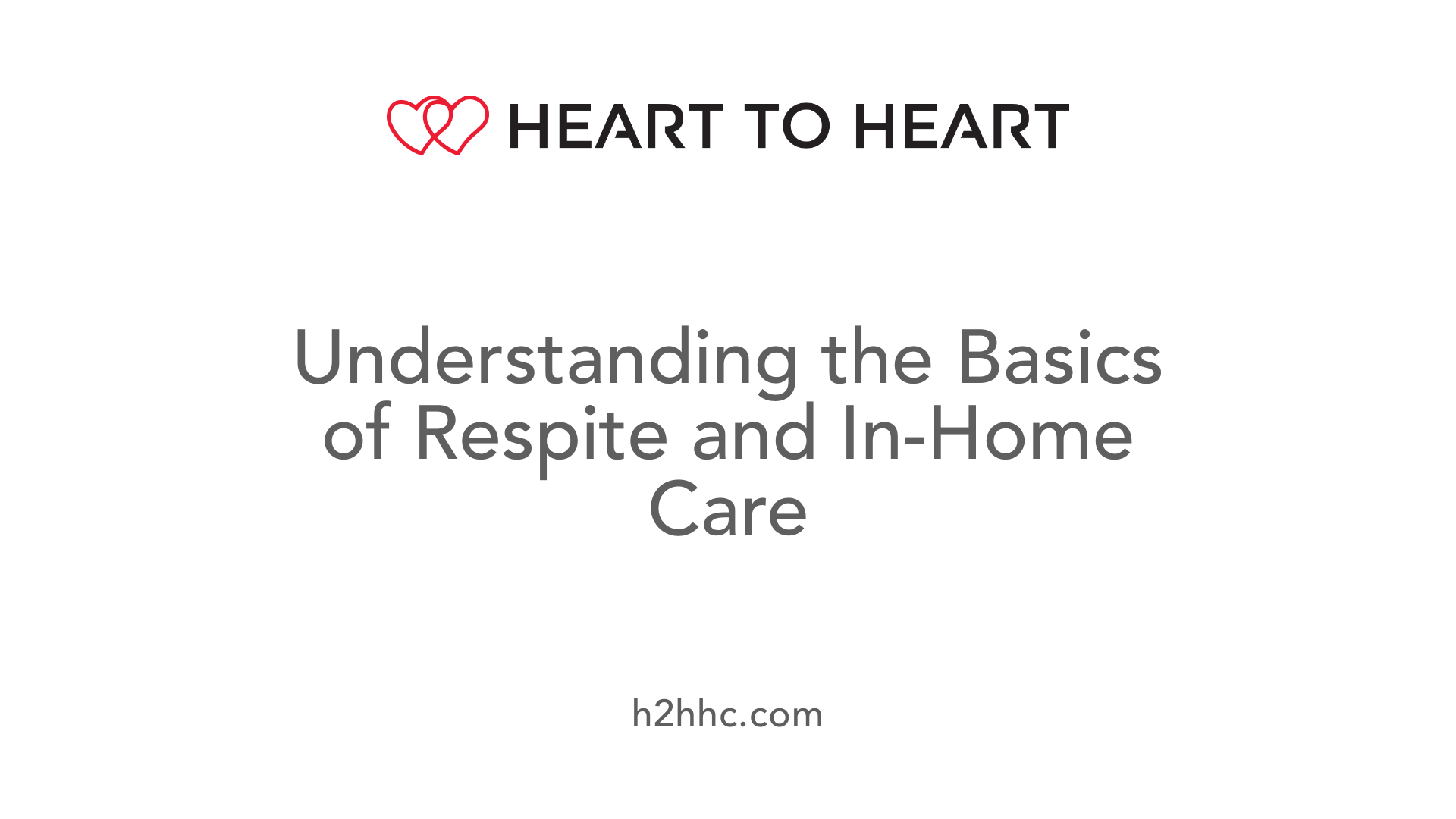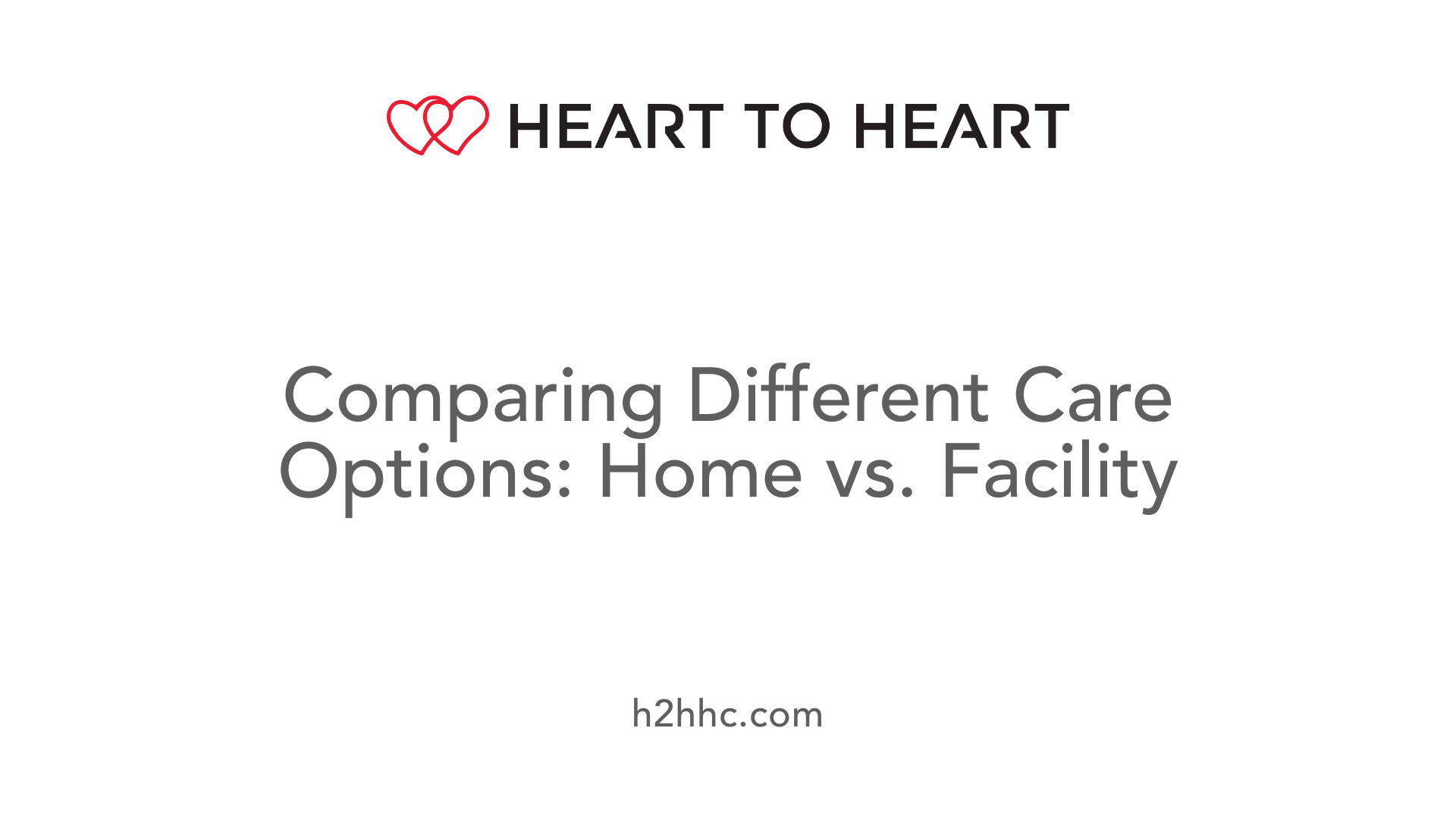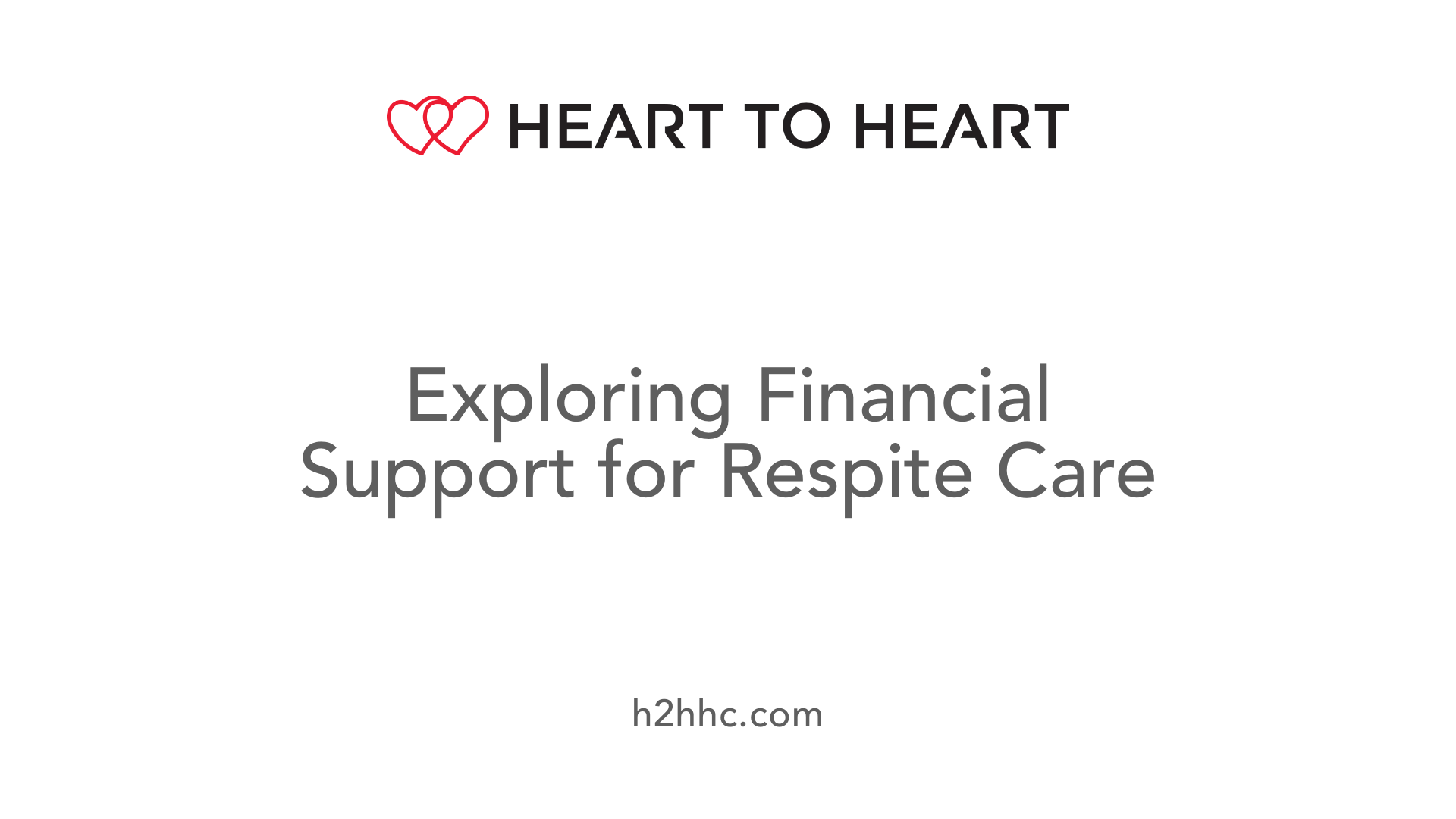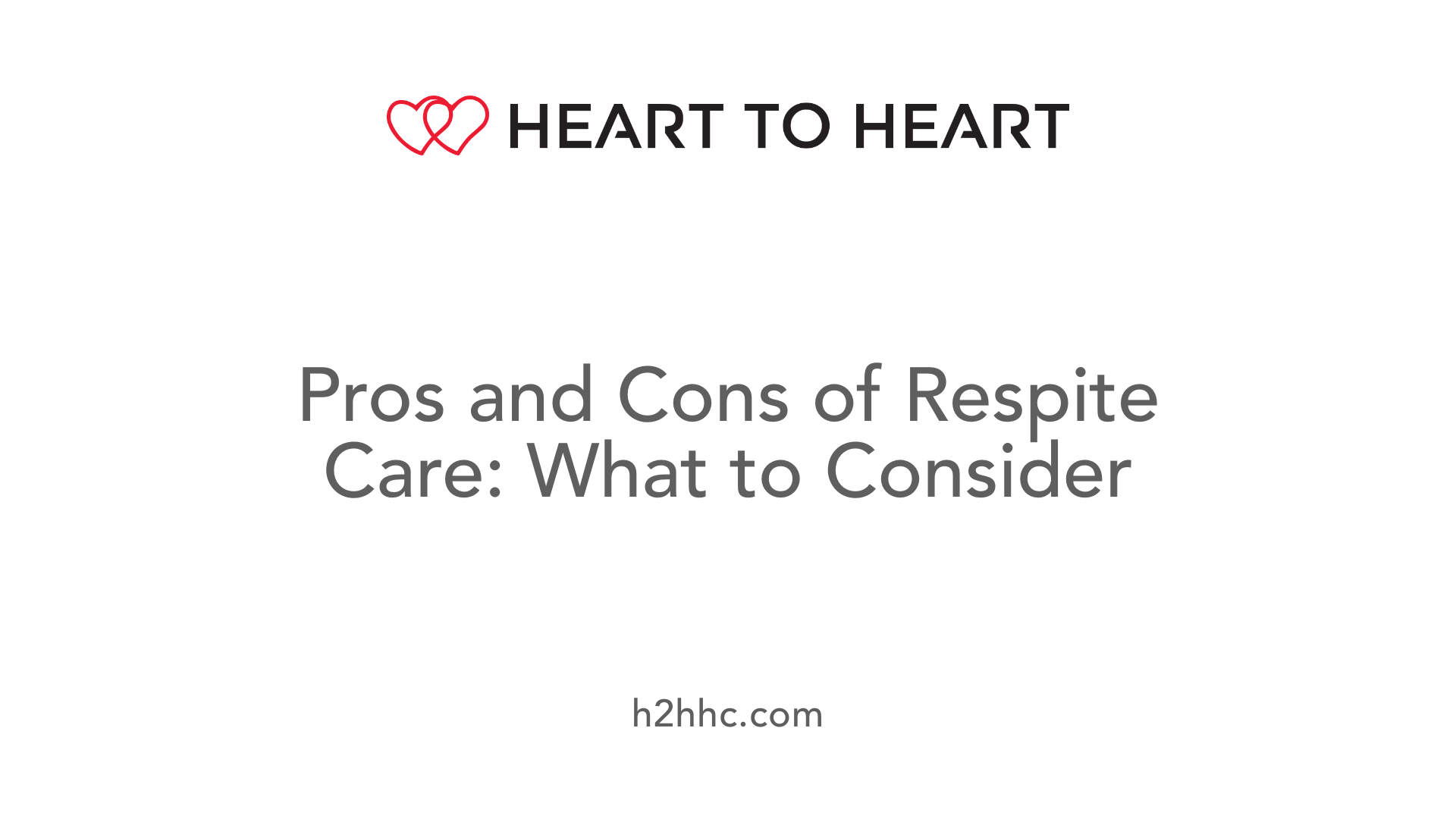Navigating Respite Care Choices: A Guide for Families
April 11, 2025

Caring for a loved one is a significant, demanding responsibility. Many caregivers face the challenge of balancing this duty with their well-being and other life responsibilities. Respite care emerges as a valuable option, offering caregivers a temporary break while ensuring their loved ones continue to receive essential support. This article explores the key differences between in-home and facility-based respite care, providing insights to help families make informed decisions.

Respite care and in-home care serve different purposes. Respite care is primarily designed as a temporary relief service for primary caregivers, allowing them to take essential breaks. This care ensures that loved ones are safe and engaged, and it can be delivered in various settings for short durations. On the other hand, in-home care provides continuous, personalized assistance within the individual's home. This type of care helps maintain independence, covering daily activities, medication management, and companionship needs.
The main objective of respite care is to offer short-term relief for caregivers, reducing their stress and the risk of burnout. By providing care recipients with professional assistance, caregivers can take a much-needed break to recharge. Respite care can help prevent the deterioration of the caregiver's health while ensuring their loved ones are cared for in a comfortable environment.
In-home care, in contrast, focuses on long-term support tailored to individual needs. This approach aims to enhance the quality of life by providing ongoing assistance with daily tasks and promoting independence. The aim is not just to fill a gap for caregivers but to create a sustainable support system for individuals requiring help due to age, illness, or disabilities.
| Care Type | Duration | Typical Settings |
|---|---|---|
| Respite Care | Short-term relief | In-home, adult day centers, or facility-based |
| In-Home Care | Long-term support | Individual’s home or assisted living facilities |
Understanding these differences can guide families in making informed choices about the type of care that best meets their unique circumstances.

Home care and facility care present distinct environments and care approaches, tailoring to different needs. Assisted living facilities provide a communal living setting where caregivers can attend to multiple residents, offering personal care, meals, and opportunities for social engagement. Care recipients benefit from fellow residents and a structured setting, which can enhance their social interaction and emotional well-being.
Conversely, home care focuses on delivering services directly within the individual's own residence. This setting allows seniors to maintain a familiar environment, contributing to their comfort and tranquility. Care in-home often includes personalized attention as caregivers concentrate solely on one client, addressing specific needs with greater focus.
When considering financial implications, assisted living facilities generally come with a median cost of about $4,995 per month. This fee covers living accommodations and a range of supportive services. In contrast, home care can become quite expensive, particularly when extensive daily assistance is required—averaging $5,720 per month for full-time services exceeding five hours a day.
The focus varies significantly between the two care types. Assisted living facilities accommodate individuals with moderate requirements, offering a blend of independence and assistance. They cater to broader community interactions and activities.
On the other hand, home care is specialized in nonmedical support but can also involve home health care, which is medically oriented and prescribed by health professionals. This nuanced differentiation is vital when deciding the appropriate care path for an individual.
| Care Type | Environment | Average Monthly Cost | Level of Personalization | Type of Care |
|---|---|---|---|---|
| Home Care | Individual's Home | $5,720 | High | Nonmedical/Health |
| Assisted Living | Communal Facility | $4,995 | Moderate | Personal Care |

Respite care can be financed through a variety of options. Typically, families may opt to cover costs out-of-pocket, depending on their financial situation. This might include hiring independent providers directly or utilizing formal respite services, which can vary in cost.
Medicare provides limited coverage primarily for hospice-related respite care, which may not cover longer-term needs. Medicaid, however, plays a more significant role and can assist families through state programs that help lower-income individuals and families afford respite services. Coverage details and eligibility criteria can vary significantly from one state to another, so families should investigate local options thoroughly.
Long-term care insurance policies often offer some coverage for respite services. However, the extent of this coverage depends on the specifics outlined in individual policies. Families should carefully review their policy documentation or speak with their insurance providers to understand what respite care services are included.
In addition to these traditional funding mechanisms, various programs and grants can help alleviate the burden of respite care costs. Nonprofits and local community organizations may offer resources, financial aid, or access to informal respite care through family or friends, which often comes at minimal or no cost.
| Financial Option | Description | Key Considerations |
|---|---|---|
| Out-of-Pocket Payments | Direct payment for hired services or facilities | Can be costly; need careful budgeting |
| Medicaid Coverage | Provides assistance in many states for qualifying individuals | Varies by state; eligibility assessments needed |
| Medicare Coverage | Limited to hospice-related respite care | Not a comprehensive solution |
| Long-term Care Insurance | May cover some respite care services, depending on the policy | Review policy specifics |
| Community Programs and Grants | Various aid programs available at local levels | Availability varies; inquire locally |
Understanding these options is crucial for families looking to finance respite care effectively, helping to ensure that both caregivers and care recipients can benefit from necessary support.

Medicare provides respite care under the Part A hospice benefit specifically for individuals facing terminal illnesses, confirmed by a physician. For those eligible, Medicare allows for up to five consecutive days of respite care during which beneficiaries can receive care in various settings, including:
During these five days, Medicare covers approximately 95% of the associated costs. However, patients must pay a 5% coinsurance, which is essential to keep in mind when planning for respite care reimbursement.
It’s important to highlight that Medicare does not cover respite care in settings such as assisted living or residential care facilities. Additionally, respite services for non-hospice circumstances are excluded.
While traditional Medicare has limitations, some Medicare Advantage plans may provide more flexibility, offering additional respite care options. Beneficiaries can inquire about:
These options can enhance the care experience, ensuring caregivers have access to a broader spectrum of support, potentially helping them maintain their well-being while caring for loved ones.
In summary, understanding Medicare's respite care provisions is crucial for families managing caregiving demands, allowing them to utilize available benefits effectively while alleviating caregiver burden.

Respite care provides numerous advantages for both caregivers and care recipients. For caregivers, it offers a vital break from daily responsibilities, significantly reducing stress and the risk of burnout. This time away allows caregivers to recharge physically and emotionally, which ultimately enhances the quality of care they can provide upon their return.
For care recipients, especially seniors and individuals with special needs, respite care can lead to improved well-being. They often enjoy the opportunity for social engagement and activities, particularly in community-based settings like adult day services. Staying in familiar surroundings during in-home respite ensures comfort, minimizing anxiety while receiving necessary support with daily tasks and medical care.
However, there are potential drawbacks to consider. Emotional challenges may arise, including guilt from caregivers who might feel apprehensive about leaving their loved ones with unfamiliar providers. Care recipients also may struggle when placed in new environments or with new caregivers, particularly individuals with conditions like Alzheimer’s or dementia who thrive in routine.
Additionally, barriers such as the availability of specialized services can complicate the decision to use respite care. Transportation costs and limited care hours at facilities like adult day centers can add to the logistical challenges families face when seeking respite services.
To help alleviate these emotional challenges, open communication between caregivers, care recipients, and the respite providers is crucial. Engaging care recipients in the selection process of their respite provider can foster a sense of control and ease anxiety. Furthermore, consistent use of respite services can help both caregivers and care recipients gradually adapt to new arrangements, effectively reducing stress associated with transitions.
Adopting flexible schedules and exploring different respite care options—whether in-home or facility-based—offers families tailored solutions that fit their unique circumstances, potentially enhancing the overall experience for everyone involved.
Respite care is a vital service that supports caregivers by offering them temporary relief, yet the cost can often be a significant barrier. Fortunately, there are several financial support mechanisms designed to assist families in accessing these necessary services.
State Lifespan Respite Programs
Many states have established Lifespan Respite Programs that provide grants or vouchers for caregivers. These programs aim to support caregivers who may not be eligible for more extensive public funding.
Home and Community-Based Medicaid Waivers
Every state offers Medicaid Waivers specifically for home and community-based services, which can include respite care. Eligibility requirements vary, but these waivers provide essential financial assistance for caregivers in managing respite care costs.
Medicare Options
The Medicare Hospice Benefit can cover respite care for terminally ill patients, allowing caregivers a break during a challenging time. Additionally, certain Medicare Advantage plans include respite care as part of their coverage, expanding access for eligible individuals.
Family Caregiver Support Programs
The National Family Caregiver Support Program provides funds through local Area Agencies on Aging, helping families access respite services among other caregiver support.
Private and Community Grants
Other options include private funding sources like the Caregiver Respite Grant Program, offering further support for those in need of assistance.
Exploring local community resources is also beneficial. Community organizations and non-profits often have specific programs dedicated to assisting families with respite care funding. This may include advice on managing expenses, finding providers, and utilizing available financial support.
Overall, identifying and utilizing these resources can greatly alleviate the financial burden associated with respite care, ultimately improving the health and well-being of both caregivers and their loved ones.
Respite care services for adults with disabilities encompass a variety of options aimed at supporting caregivers effectively. These include:
Funding for respite care can come from various sources, enhancing accessibility for families. Notably, many states provide Respite through Medicaid Home and Community-Based Services (HCBS) waivers, allowing for reimbursement to caregivers. Long-term care insurance policies may also cover respite services, offering another layer of support. Additionally, programs such as the Lifespan Respite Care Program have been established to improve accessibility and coordination of respite services, emphasizing their importance in caregiver support.
Utilizing respite care provides significant advantages for both caregivers and care recipients. For caregivers, it fosters improved mental and physical health, reducing stress levels significantly. They gain necessary breaks to recharge, ultimately leading to a more sustainable caregiving experience. For adults with disabilities, respite care offers opportunities for social engagement, fostering improved mental well-being while maintaining a routine in a safe environment. This shift not only enhances quality of care but also aids in the overall emotional and physical health of both parties involved.
In-home respite care enables care recipients to remain in a familiar setting, significantly reducing anxiety that can arise from being in an unfamiliar place. This is especially advantageous for individuals with special needs, who may require specific adaptations in their home environment to feel comfortable and secure.
Caregivers benefit greatly from in-home respite as well. With no transportation hassles for the individual receiving care, caregivers can feel less stressed. Additionally, in-home respite can be a cost-effective solution, particularly if families hire and train their own providers, rather than relying on agency services with higher fees.
In-home respite care is highly customizable, allowing it to meet diverse needs. Services can range from assistance with daily living activities, health management, to companionship. This flexibility not only helps maintain the individual's independence but also assures caregivers that their loved ones are cared for in a familiar environment, which can enhance overall well-being.
The level of care can also be tailored to the individual recipient, ensuring they receive personalized assistance that correlates with their specific requirements. This is a significant contrast to institutional care, where personalization can be limited.
When considering in-home respite care, it's crucial to select the right provider. A checklist for hiring includes conducting thorough telephone screenings, interviewing candidates in person, and checking their references and qualifications. Ensuring that the provider has experience relevant to the individual's needs is key for successful outcomes.
Families should also look for background checks and ask about the training that respite providers have undergone. Additionally, involving the care recipient in the selection process can help ease the transition and ensure a better match. This proactive approach supports not only the caregiver's need for respite but also the well-being of the care recipient.
Facility-based respite care includes various environments tailored to meet diverse needs. Common options include:
Facility-based respite care is designed to cater to various aspects of care, ensuring well-rounded support for recipients. Services may include:
When choosing a facility for respite care, several factors should be considered to ensure quality care:
| Type of Facility | Ideal For | Services Offered |
|---|---|---|
| Assisted Living Facilities | Seniors needing minimal support | Personal care, social activities |
| Skilled Nursing Facilities | Individuals requiring medical care | Comprehensive medical support |
| Respite Centers | Families needing short-term relief | Immediate care, recreational programs |
| Crisis Nurseries | Families in crisis | Immediate support, emergency services |
By evaluating the variety of options and the services provided, families can make informed decisions that best suit their caregiving needs.
Caregivers play a vital role in the lives of individuals with disabilities, chronic illnesses, or age-related challenges. In fact, about 53 million adults in the U.S. provide long-term care, averaging 24 hours of direct care each week for over four years. This significant demand often leads to overwhelming stress and health declines among caregivers. Providing the necessary support through respite care not only benefits the caregiver but also enhances the well-being of those receiving care by ensuring they have quality and consistent support.
Despite the clear benefits, the majority of caregivers—approximately 85%—do not utilize formal respite services. Various barriers contribute to this reluctance, including long waitlists, lack of awareness about available options, and misconceptions regarding the necessity of respite care. Furthermore, challenges related to costs and complicated eligibility criteria can deter families from seeking the relief that respite services could provide.
Utilizing respite care can significantly improve caregivers' quality of life. Regular use of respite services is associated with reduced hospitalizations and a decrease in caregiver burden. These services allow caregivers to recharge, maintain their health, and reinvigorate their ability to provide care. Engaging in respite care leads to enhanced mental and physical well-being, while recipients of care enjoy improved social interaction and specialized attention that can invigorate their daily lives.
| Type of Respite Care | Description | Benefits |
|---|---|---|
| In-Home Respite | Care provided within the familiar home setting | Comfort, personalized care, continuity of routines |
| Out-of-Home Respite | Programs outside the home for social interaction | Opportunities for social engagement and new experiences |
| Facility-Based Respite | Short stays at specialized centers | 24-hour care and intensive support |
In summary, understanding the vital support system that respite care offers to both caregivers and care recipients is essential for fostering a healthier caregiving environment.
States are continuously evolving their respite care programs to meet the diverse needs of caregivers and care recipients. Innovations include flexible policies that allow for pooling unused respite benefits for future use, enabling caregivers to maximize their support options. Additionally, self-direction programs have emerged, offering caregivers the autonomy to hire friends or family members as respite providers, which can foster more personal and trusted care environments.
Many states have recognized the crisis surrounding caregiver burnout and are developing initiatives to alleviate this burden. Programs funded through Medicaid Home and Community-Based Services (HCBS) waivers are expanding access to respite services, ensuring that caregivers can benefit regardless of their financial situation. Moreover, some states have increased reimbursement rates for respite care providers, enhancing service availability and encouraging provider engagement in the offering of respite services.
Despite the reported benefits of respite care, awareness remains a challenge, with 85% of caregivers not utilizing formal respite services. To combat this issue, state initiatives are focusing on outreach and education. Campaigns are being launched to inform caregivers about existing services, eligibility criteria, and application processes. By increasing public awareness and understanding of available respite opportunities, these programs aim to close gaps in support for caregivers, making assistance more accessible.
| Initiative Type | Description | Impact |
|---|---|---|
| Self-Direction Programs | Allow caregivers to select friends/family as paid providers | Increases trust and personalized care |
| HCBS Waivers | Expand Medicaid coverage for respite services | Increases service accessibility |
| Outreach Campaigns | Educate caregivers on available respite resources | Boosts utilization rates |
By reinforcing and investing in these state and national initiatives, the gap between caregivers and respite services can be bridged, leading to improved well-being for both caregivers and the individuals they care for.
When considering respite care, families must assess the specific needs of the care recipient. In-home respite care offers comfort as it allows individuals to remain in their familiar surroundings, minimizing anxiety especially for those with special needs. Conversely, facility-based care may provide a supportive community environment, beneficial for social interactions and new experiences that foster development.
Transportation logistics can also sway this decision. In-home care eliminates stress related to transporting the individual and can be more economical if families directly hire and train helpers.
Each care recipient has unique requirements that play a crucial role in selecting the appropriate care setting. For instance:
Families must also consider logistics such as budget, availability, and types of services offered. Evaluating the caregiver's qualifications is essential, particularly in situations where families hire individuals directly. A checklist can assist:
Ultimately, the decision should align with both the care recipient's needs and the family's overall well-being, ensuring that the support system enhances care quality and minimizes stress.
Respite care offers numerous benefits, alleviating caregiver burden and providing enhanced care to loved ones. Understanding the distinct characteristics of in-home versus facility-based options is essential for choosing the right care model. By evaluating personal needs, financial situations, and available services, families can make informed decisions that benefit both caregivers and care recipients.
09:00 AM - 06:00 PM
Monday - Friday
2488 Grand Concourse Suite 409, Bronx, NY, 10458
T: 718-305-5858
F: 718-305-6258
1 Smith Street, 3rd Floor, Brooklyn, New York, 11201
T: 718-305-5959
F: 718-305-6259
2361 Nostrand Ave Suite 401 Brooklyn, NY 11210.
T: 718-305-6060
F: 718-305-6260
576 Central Ave # 301, East Orange, NJ 07018
433 Woodbury Glassboro Road Sewell, NJ 08080
1172 Fischer Blvd, Toms River, NJ 08753
T: (973) 678-5500
njinfo@h2hhc.com








